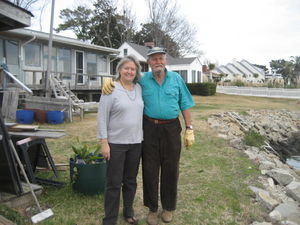Advertisement
Published: January 19th 2008

 Leaving from Rudee Inlet
Leaving from Rudee Inlet
Donna and Mason wave us off2008 Pacific Voyage
January and a new moon are used as depictions of new beginnings. So it was that with a new moon occurring on 9 January 2008, Marnie and her crew of two, Tigs and Walter, left the dock in Rudee Inlet, Virginia Beach with Donna and Mason to wave farewell. Marnie, the 62 foot wooden ketch, was to return home having been commissioned and built in Auckland NZ on 15 April 1985 at the Salthouse Shipyard. The destination to be reached within 10 months of cruising through unexplored waters for those aboard.
The first leg of the southward journey was anticipated to be a four day passage, with landfall in Spanish Wells, Bahamas. The first twenty four hours of the journey we experienced favourable winds from the south west as we rounded Cape Hatteras. This area is known as the ship graveyard of the Atlantic because of the high probably of huge seas forming by the convergence of the gulf stream and northerly gails that frequent the area, along with shoal waters created by the cape (jutting out into the Atlantic). On day two the wind shifted and increased as we beat into a 25-35 knot southerly

 On the ocean at last
On the ocean at last
Virginia Beach in the rear view mirrorand high seas for the next five days. Along with the wind came squalls and thunderstorms. When the wind finally shifted to the west the crew sighed with relief.
Overall it proved a laborious, sloppy seven-day sail with Tigs finding her sealegs after four days of feeling remarkably sleepy. Walter unsurprisingly appeared to have been wearing his throughout the five months of preparation for the voyage.
Within just this seven day passage, minor disasters struck on two occasions. On the second day the foreward teak hatch combings were smashed into pieces by the dinghy, which although securely fastened, was knocked adrift by heavy seas washing over the bow. To replace them would involve locating suitable teak, creating a pattern, the use of a workshop with bandsaw, table saw, clamps etc, all a challenge in the third world now entered. On another occasion, when beating into the 25-30 knot southerly wind and seas, the wire jib halyard parted at the top and by the time the sail was wrestled down was torn along the luff. This left us without the ability to beat into the wind which fortunately was predicted to go around within 24 hours, and did.
Advertisement
Tot: 0.225s; Tpl: 0.01s; cc: 19; qc: 63; dbt: 0.0675s; 1; m:domysql w:travelblog (10.17.0.13); sld: 1;
; mem: 1.1mb

 Leaving from Rudee Inlet
Leaving from Rudee Inlet
 On the ocean at last
On the ocean at last
















